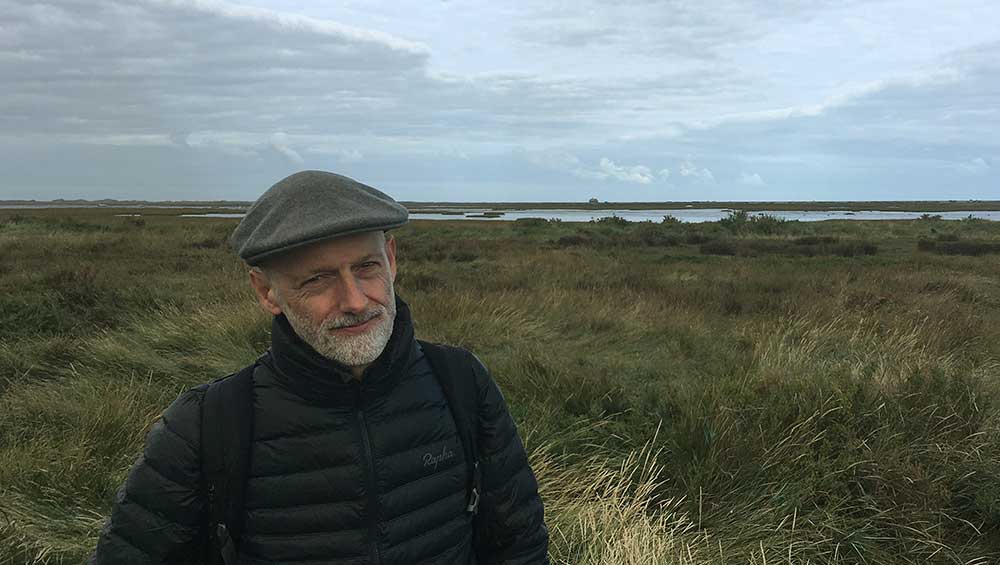
John Riddy portrait, courtesy the artist.
by DAVID TRIGG
The particularity of place and the transformation that occurs when the visible world is translated into a photograph is a central concern in the work of John Riddy (b1959, Northampton). Whether photographing in the urban environment or rural landscapes around the world, the London-based artist responds to each location with elegantly composed images that combine formal exactitude and a lyrical sensibility. Consistently working in series, Riddy has captured the character and atmosphere of places and architectural settings in countries as disparate as Italy, South Africa, the United States and Japan. In all his work, he attempts to frame the tension between photography’s capacity to factually describe a space and its illusory claim to objectivity.
Riddy’s new exhibition, Horizon, at Frith Street Gallery, Golden Square, London, comprises nine landscape photographs all taken from a single viewpoint looking toward Blakeney Point on the north Norfolk coast. In each, the composition is bisected by a shingle ridge, which separates the saltmarsh in the foreground from the sweeping sky above. The horizon line is interrupted by a solitary building known as the Watch House, a disused coastguard station that was originally used as a lookout for smugglers and sailors in distress. Made over two years, the series captures the scene as its appearance changes across the seasons, tracing the effects of weather and light on the landscape, and the shifting sky. It is the product of a drawn out, time-consuming process, both in the field and in Riddy’s south London studio.
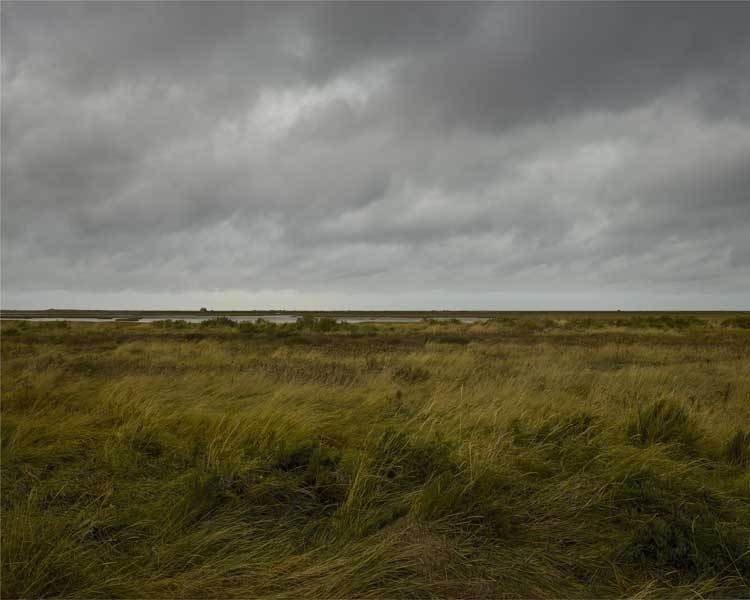
John Riddy, Blakeney (1), 2021. Archival pigment print, 98 x 123 cm. © John Riddy, courtesy Frith Street Gallery.
Unlike many of the places he has photographed, Blakeney is a location with which Riddy is deeply familiar. He was first introduced to the area in the early 1990s by the artist Roger Ackling (1947-2014) and his wife Sylvia, who owned a cottage in Weybourne. “It was an old coastguard’s cottage, right on the cliff edge,” he recalls. “We used to walk quite a lot when we were there, and I’ve visited the area regularly ever since.” Even though Riddy has been visiting Blakeney for more than 30 years, this is the first time he has photographed there. “I know I sometimes get put under the umbrella of landscape photography, but I’ve never been fixated on the idea of making a landscape,” he says. Indeed, across his oeuvre, landscape has always been subordinate to his primary interest in documenting the formal qualities of place.
Several of Riddy’s projects have had their starting point in the art of the past, such as Hokusai’s woodblock prints, Gustave Le Gray’s photographs and even John Ruskin’s autobiography. The impetus for the Blakeney photographs, however, stemmed from a concern with composition. “I’d been thinking a lot about the formal division of an image,” Riddy explains, “and, in 2017, I saw Brice Marden’s terre verte show at Gagosian. I really loved the presence those works had together in the gallery; the way they were formally aligned reminded me of a horizon. I started to wonder if it might be possible to do something similar with a sequence of photographs, to have a horizon line that went round the gallery.” Having settled on the idea, his thoughts soon jumped to Blakeney: “I wanted a horizon and I knew where there was one.” Although he could have chosen from many locations, it was important to use a place with which he had enjoyed a long relationship. “It’s not something you can detect in the images, but I think my familiarity with Blakeney has affected the work, even if it’s all subcurrent.”
-2016.jpg)
John Riddy, New York (Black Star 4), 2016. Archival pigment print, 112 x 98 cm. © John Riddy, courtesy Frith Street Gallery.
This is not the first time that Riddy has recorded a single viewpoint over an extended period. The New York (Black Star) series from 2016 shows us Lower Manhattan across a single day, focusing on the view from the 14th floor of the Standard hotel in Greenwich Village. Black Star 1 was taken at night, showing the city illuminated by artificial light, while in Black Star 2, 3 and 4, which were taken within an hour of each other, we see the same scene in the day as thick rainclouds envelop the soaring skyscrapers in the distance, including One World Trade Center. In the foreground is the Whitney Museum, with Frank Stella’s two-tonne Black Star (2014) sculpture sitting like a Christmas decoration on its fifth-floor roof terrace. The Standard hotel’s floor-to-ceiling windows provided the perfect vantage point for Riddy, who digitally stitched together his photographs from multiple files so as to achieve a consistent degree of detail across the image. More important, though, was that the view was not in any way unique. “Thousands of people stay in those rooms, and I like the idea that I’m doing something that countless others have done: waking up in the morning, looking out of the window and taking a photo.”
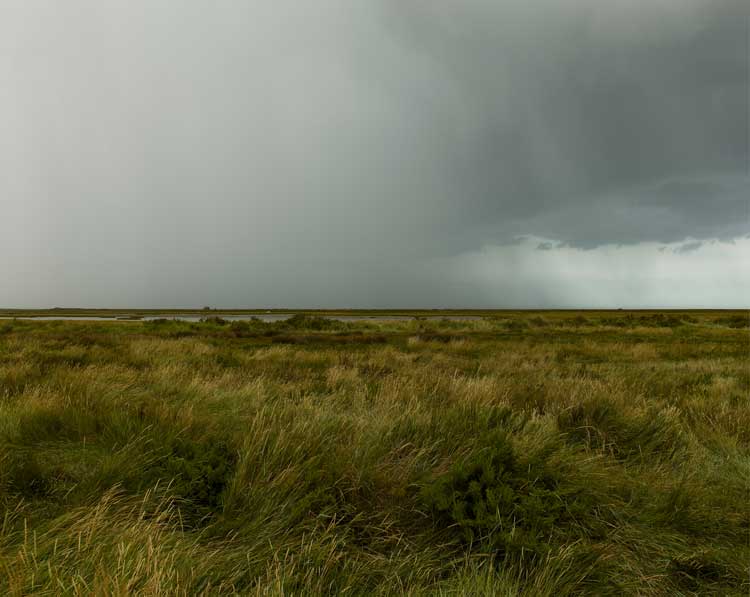
John Riddy, Blakeney (6), 2022. Archival pigment print, 98 x 123 cm. © John Riddy, courtesy Frith Street Gallery.
Blakeney Point, though seemingly remote, is similarly familiar to the thousands of walkers and birdwatchers who visit the Norfolk Coast Path each year. Running from Hunstanton in west Norfolk to Hopton-on-Sea on the north-east coast, it follows the Point’s four-mile-long shingle spit with vast open marshland and expansive skies. Riddy tried a few different viewpoints along the path before settling on a spot looking towards the North Sea. The weather-beaten landscape here has a lurking, almost primeval quality that, unlike the sky above, hardly seems to change from month to month. “It’s a big sky in Norfolk and things happen so quickly, sometimes the weather really blows,” says Riddy, who photographed the view in all seasons. In Blakeney 6 (2022), dark, brooding clouds loom over the windswept grass, recalling Rembrandt’s famous etching The Three Trees (1643), a favourite of Riddy’s. “I really wanted that storm,” he recalls, “and I got absolutely soaked.”
“It’s really important that I set my camera up just off the path that everybody walks along,” explains the artist, who often speaks with passersby as he works. “People love to know what I’m doing, though they probably imagine it’s some kind of Instagram project.” Riddy’s results are, of course, far superior to those of the casual snapper with a phone, who could never match the depth, intensity and complexity of colour achieved by his prints, the technical brilliance of which owe much to rigorous post-processing. Hours that were once spent burning and dodging in a darkroom are now expended making minute adjustments in Photoshop and printing numerous test prints on his large format Epson printer, which are then tacked to the wall of his studio for appraisal. “It’s about getting the tonal values and colour to sit right,” says Riddy, who starts with a large number of A2 tests before switching to the full-size paper and making his familiar 98cm x 123cm archival pigment prints – the largest his printer can handle.
-2012.jpg)
John Riddy, Palermo (Via Della Loggia), 2012. Archival pigment print, 74 x width variable. © John Riddy, courtesy Frith Street Gallery.
Riddy taught himself how to use his printer, as he did with Photoshop. “I don’t follow any rules with the software, as long as what I end up with is alive,” he says of his trial-and-error approach. Indeed, Riddy has never formally studied photography and is largely self-taught. Having decided to pursue the medium seriously in his mid-20s, he invested in a folding Linhof camera and devoured Ansel Adams’ three-volume set of practical photography books: The Camera, The Negative and The Print. But photography has been in his blood since childhood: he was shown the basics by his father, a keen amateur photographer who had a darkroom at home. The bug really caught him on his art foundation course at Coventry polytechnic in 1980, and even when he was studying painting at Chelsea School of Art, he continued taking photographs.
It was after completing his master’s in 1984 that he started working for Anthony Caro as a studio photographer. “I quickly became the photographer of choice for various artists,” he says, and before long he was working for figures such as Anish Kapoor and Lucian Freud, documenting their works for publication. Through working for the Annely Juda Gallery, he had access to professional cameras, which he was able to use for other projects, too. “The great thing about working for other artists and galleries was that I was using a large-format camera all day, every day, which I think has had a huge effect on what I do. I learned on the job. I really did get paid to learn and my own work came out of that.”
Unlike previous projects, such as the New York (Black Star) series, each of the Blakeney photographs are a single shot; there is no digital stitching, cropping, or cutting and pasting. “They’re single frame because otherwise you wouldn’t keep up with the cloud movements, and the grass blowing in the wind; the exposure time would be too long,” he explains. “Because the clouds and everything change so much, the difference between a frame that really works and one that doesn’t can be a matter of seconds.” Consequently, Riddy has taken close to 1,500 images from which he has selected nine to be printed for the exhibition. “It is completely the opposite to how I’ve always worked before, where I would spend ages setting everything up, take a handful of photos and go home.”
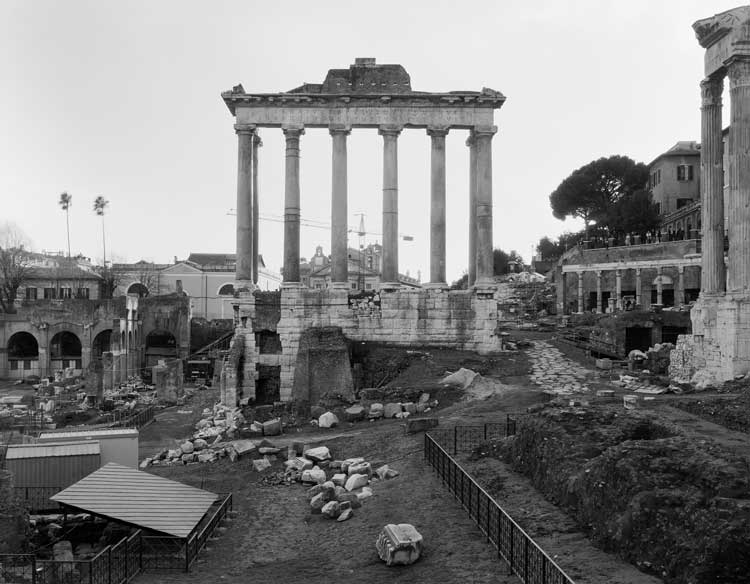
John Riddy, Rome (Forum), 1999. Gelatin-silver print, 38 x 48 cm. © John Riddy, courtesy Frith Street Gallery.
The test prints are studied and compared, often over extended periods, until the changes that are needed become apparent. “I spend a lot of time making things warm or cool, just nuancing the values on the computer. I’m looking for an overall intensity. It’s a very intuitive process and there’s a pretty fine line between a print that works and one that doesn’t.” Surely it was tempting to use Photoshop to combine the perfect sky from one image with the perfect foreground of another? “I could have done that,” he says, “but I haven’t. It’s amazing how quickly things like that fall apart visually, there’s just something about it that looks fake.” In striving for the perfect print, Riddy’s fastidiousness borders on the obsessive, but it is an approach that the photographer deems essential. “I don’t want to make an ordinary print; I want every print in the show to be exceptional,” he says.
For Riddy, it is not just about the individual prints, but about how they work together. “I really want there to be an intensity to everything when you walk into the Frith Street show,” he explains. This has meant developing the exhibition in dialogue with the physical space. “I did a practice hang in the gallery where I Blu-Tacked the images to the wall, but I realised that it needed to be better, there simply wasn’t enough modulated intensity between them.” Making an exhibition from a single, repeated view has proved to be more challenging than he anticipated, especially when the differences between each image appear at first to be quite minimal. “With this approach, you lose the interactions and the rhythms between different viewpoints and perspectives. It also rules out different spatial relationships as you walk round the show, so it’s been quite demanding to get these images aligned.” It is for this reason that Riddy, a longtime practitioner of black-and-white photography, chose to shoot the series in colour. “It’s so much about the colour of the grass in relation to the colour of the sky. The way the grass changes colour is really fundamental to whether it is compelling or not.”
-2017.jpg)
John Riddy, London (Rail Sidings Road 1 and 2), 2017. Archival pigment print, 98 x 123 cm each. © John Riddy, courtesy Frith Street Gallery.
The way Riddy talks about the subtleties of colour belies his training as a painter, which is another subcurrent of his photographic practice. With the Blakeney series, one naturally thinks of Claude Monet’s Rouen Cathedral paintings of the 1890s, in which the French impressionist captured the church’s facade as it appeared at different times of the day and year. And there are evocations here of landscape painters such as Philips Koninck, Caspar David Friedrich and John Constable, the latter having had a significant influence on Riddy. Other photographs, too, evoke the work of painters. Take the monumental diptych London (Rail Sidings Road 1 and 2) (2017), which depicts the brick walls of a 19th-century pedestrian underpass. The accumulation of dirt, grime and stains in these images possesses a certain painterliness, while the interplay of textures, light and colour conspires to describe the wall’s abstract qualities. Riddy has said that painters were very much in his mind while working on these images, yet he insists that his works must be seen as photographs first and foremost. “I think about painting a lot, but the last thing I want is for people to think that my work in some way alludes to painting. It’s got to be a photograph, straight forward within the language of photography.”
-2005.jpg)
John Riddy, Shin-Fuji (Street), 2005. Lambda C-type print, 47 x 59 cm. © John Riddy, courtesy Frith Street Gallery.
Riddy’s photography has taken him all over the world. His Peninsula photographs (2012-16), which were shot as he rode his bicycle through some quite adverse terrain, record the rural countryside and townships of South Africa. Another series, Views from Shin-Fuji (2005), capture Japan’s most famous mountain from the semi-industrial outskirts of the city of Shin-Fuji, while the Palermo series (2012-16), inspired by Le Gray’s 19th-century photographs of the Sicilian capital, show the rugged streets as they appear more than 160 years later. “From when I was young, I found going on journeys and seeing somewhere new to be the greatest thing in life,” Riddy says of his love for travel. “I’m really affected by the atmospheres of different places. I love the process of going to places and seeing what you can discover when you get there.”
To mark the centenary of the death of Ruskin in 2000, Riddy produced the Praeterita series, inspired by the Victorian polymath’s unfinished autobiography of the same name, a Latin word that translates to “of things past”. Ruskin’s unconventional account of his life is notorious for its lack of focus, presented almost like a kind of travelogue, recalling over its 28 chapters the places that most touched him. Starting in London, Ruskin takes the reader across the channel to Paris, down through the Alps and into Italy. The book provided a clear framework for Riddy, who travelled to a location from each of its chapters and made a photograph there. The series, which takes in views of Oxford, the Thames, a Calais beach, the Pennine Alps and the Roman Forum, was conceived as a single installation for the Ruskin Gallery in Sheffield, where each image was displayed without labels or distracting explanatory texts.
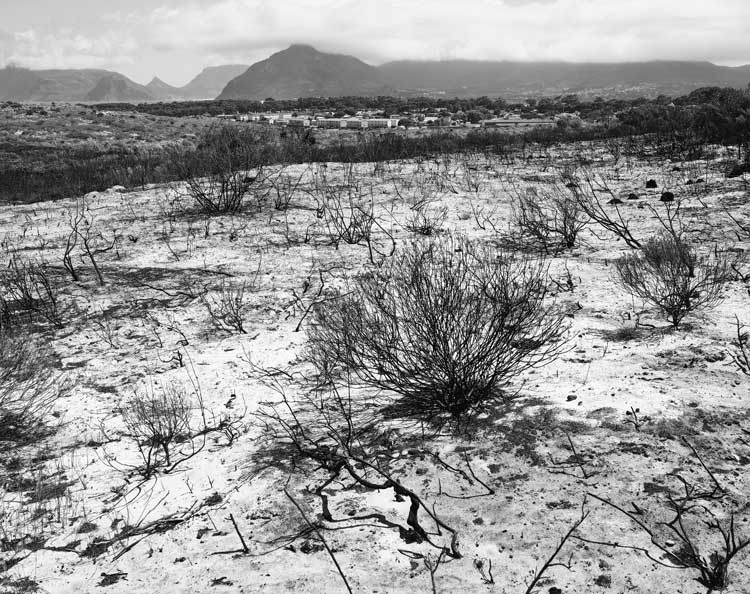
John Riddy, Peninsula (Ocean View 5), 2015. Archival pigment print, 18 x 23 cm. © John Riddy, courtesy Frith Street Gallery.
Recent travel restrictions around the pandemic, coupled with an increasing concern for the environmental impact of far-flung travel, have led to a diminishment in Riddy’s international excursions. This was one of the reasons why making a body of work in the UK became a priority for the artist, as was his decision to leave his car at home. “I wouldn’t have felt very good about burning up litres of petrol to make this show, so I’ve done it all on the train and the bike,” he says of his many 260-mile round trips to Norfolk. “I cycle to Liverpool Street, train it all the way up to north Norfolk, cycle to Blakeney with all my kit in my rucksack, do my work and then come back again.” It is an approach made possible only by the advancement of digital photography. “There’s no way that I could have done all of this on my bike pre-digital,” he says, recalling the weight of his large-format camera. “I walk round with so much less gear on my back now. I can go out with my digital equipment and take as many photos as I like.”
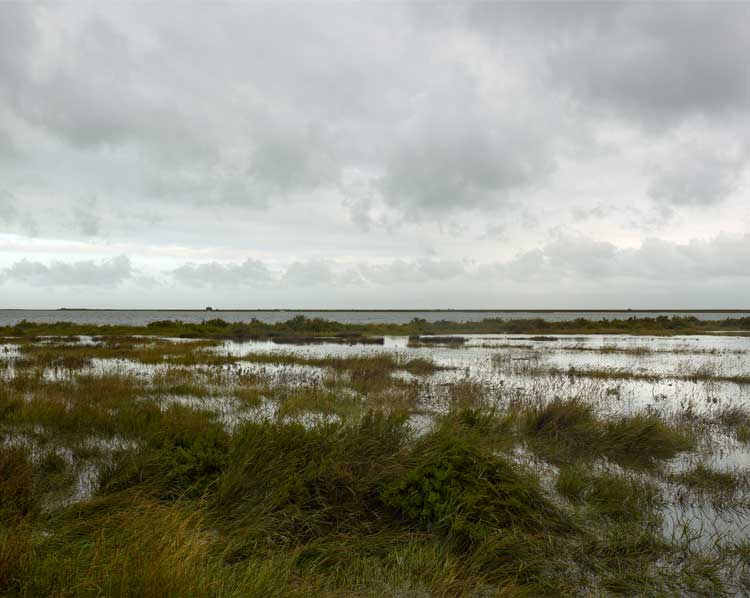
John Riddy, Blakeney (8), 2022. Archival pigment print, 98 x 123 cm. © John Riddy, courtesy Frith Street Gallery.
While the environmental dimension of the Blakeney photographs is another subcurrent, Riddy is certainly concerned for the future of such coastal sites, which are increasingly under threat from rising sea levels due to climate change. “I’m conscious that this view could vanish in the future,” he says. “If all of the predictions are correct, the spit may actually disappear back under the sea.” This is alluded to by Blakeney 8 (2022), taken on the autumn equinox, in which the familiar saltmarsh is largely covered in sea water as a result of the high spring tide. “I’ve only seen that happen once,” says Riddy. “I took the photo and then it disappeared, right in from of my eyes.” In this image, the small Watch House on the horizon appears even more vulnerable and isolated. Dwarfed by the expansive landscape and threatened by the encroaching sea, it stands as a symbol of the precarious ecological situation we all find ourselves in.
Shots like Blakeney 8 are the result of Riddy’s patient looking. He has spent hours at this spot, watching the landscape change under shifting light and weather. The mood conveyed by the resultant body of work is one of silence and stillness, which creates a unified atmosphere within the gallery. The differences between images are at times subtle, which is why Horizon invites viewers to eschew any compulsion they might have to hurry. This is a show that rewards protracted viewing. Indeed, the time that Riddy has invested, from the long days spent standing in the landscape, to the hours of post-processing, is quite apparent in each of the nine contemplative images. “I think this is the most meditative and slow thing I’ve done,” he concedes. As the author and Slow Movement advocate Carl Honoré writes in In Praise of Slow (2005), one senses that Riddy has been “savouring the hours and minutes rather than just counting them”.
• John Riddy: Horizon is at Frith Street Gallery, Golden Square, London, from 18 November 2022 to 14 January 2023.
Click on the pictures below to enlarge